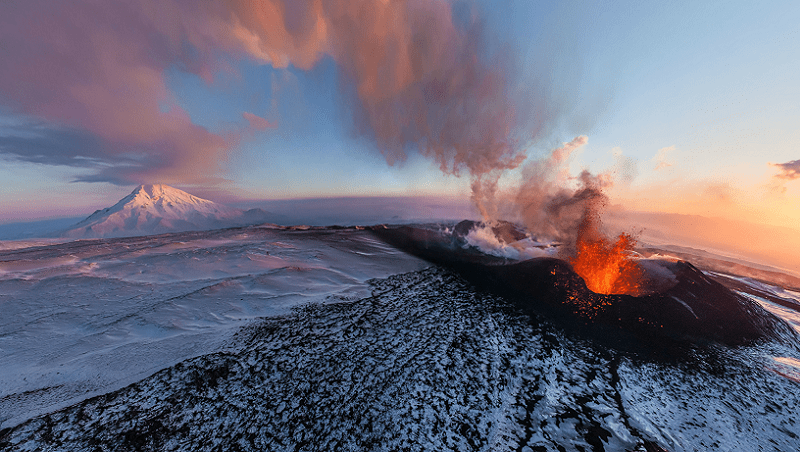
Mount Erebus Facts
- Perhaps most notably of all, the incredible Mount Erebus looks like something one might expect to see in a movie scene set on another planet. Not content to simply stop there, though, the truly fabulous location holds yet another extraordinary claim to some reasonable fame.
- That holds true due to the surprising fact that the incredible marvel of Nature and geology also ranks as the second highest volcano in its part of the world. The breathtaking volcanic mountain also forms part of what’s now known by the name of the Pacific Ring of Fire.
- This feature itself currently includes over 160 known active volcanoes. The impressive volcano has been continuously active since the year 1972. In fact, this remarkable geological feature remains the most active such feature in its particular, highly remote, part of the globe.
- Also worthy of note remains the fact that Sir James Clark Ross represented the first known non-indigenous human in our time to see this sight. The renowned explorer also discovered the distinctive mount in 1841. That discovery also took place during an active eruption.
- He subsequently named both this fabulous site, and a companion named Mount Terror, after his two sailing ships. The name Erebus derives from a region in ancient Greek mythology. Any in-depth exploration of the remarkable Mount Erebus, however, did not occur right away.
- In fact, the first recorded attainment of the summit by humans only occurred in 1908. But this was accomplished by a full team of explorers. The first solo reach of the summit did not take place until 1985. A robotic probe first explored the interior of the volcano in 1992.
Related Articles
Mount Erebus Physical Description
The eerily breathtaking Mount Erebus today ranks as one of the most truly amazing and phenomenal ultra mountains in the world. Astonishingly, the volcano itself actually appears to have been more or less continuously active for a period experts believe measures about 1.3 million years.
Fortunately, much like Stromboli, its unusual combination of mild but constant activity provides an extremely rare opportunity. That active state permits the existence of long-term observation, especially since the summit of this mesmerizing volcano itself sits at an incredible altitude.
This characteristic measures approximately 12,448 ft (3,794 m) in total height. Astonishingly, the apex of the extremely remote mountain also contains what’s known to science as a persistent lava lake. This represents one of only five such lava lakes on the entire planet known to man.
Its unique location also ubsequently created some incredibly unique geological features in the immediately surrounding region. In point of fact, some of these actually exist nowhere else on Earth. For example, the flank of Mount Erebus remains covered with hundreds of fumaroles.
Understandably, these numerous volcanic features constantly emit vast quantities of steam in the freezing conditions. As a result of the impressive combination of uncommon conditions, an incredible ongoing action takes place. This creates a truly otherwordly atmosphere for its visitors.
That’s because the unique combination of super-heated steam and sub-freezing temperatures creates gigantic hollow towers of ice. Even more impressive remains the fact that, dotting the landscape, some of these eye-catching towers measure as much as roughly 60 ft (18.3 m) in height.
Mount Erebus Location and Modern History
Amazingly, the fantastic Mount Erebus formed in what easily qualifies as one of the most unexpected locations on the entire planet. That’s because the mesmerizing wonder of ongoing geological processes formed on the extremely remote and desolate site of Ross Island.
This feature itself also formed located deep within the region known as Antarctica. It’s location also happens to make it the southernmost active volcano in the world. Due partly to its extreme remoteness and inaccessibility, its exploration occurred only relatively recently, in modern times.
In fact, the first detailed exploration of the astounding region by an official scientific team did not take place until December of the year 1912. Due to its undeniably great scientific importance, two of the camps used at that time have now been deservedly recognized for their historic significance.
Not to be outdone, the amazing site also boasts the presence of numerous breathtaking caves. Most of these features remain closely associated with the better known fumaroles. Mount Erebus ceaselessly continues to amaze scientists even today, in their continuing research, though.
That holds true because of yet another remarkable fact. Even in such a location, various forms of life manage to appear. That’s because several varieties of fungi and bacteria make their home in the caves. Many scientists therefore have strong interests in studying these fascinating locations.
Features Sharing Its Range
Check out our other articles on 5 Rare Mind-Blowing Cloud Types, Long Eared Owl, Whitehaven Beach, Hawaiian White Hibiscus, Goblin Shark, Wood Frog, Komodo Dragon, Weka
